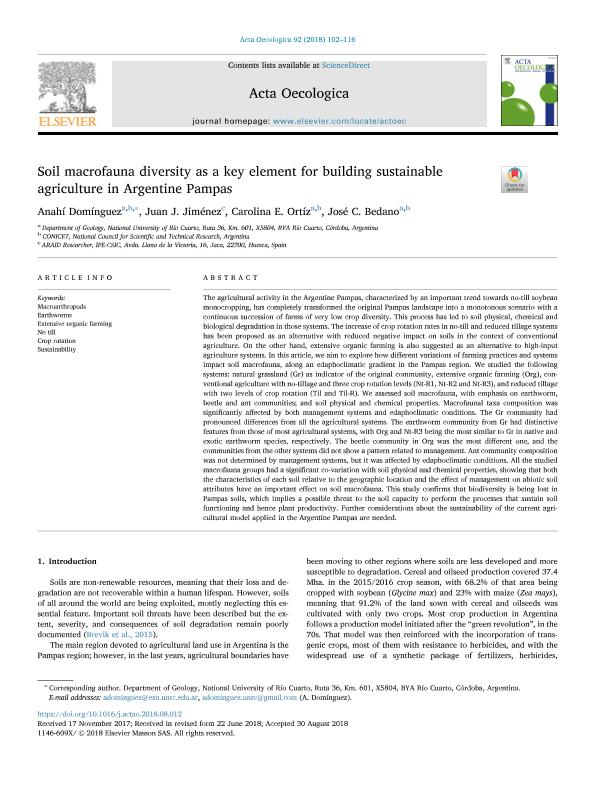Mostrar el registro sencillo del ítem
dc.contributor.author
Domínguez, Anahí

dc.contributor.author
Jiménez, Juan José
dc.contributor.author
Ortíz, Carolina E.
dc.contributor.author
Bedano, José Camilo

dc.date.available
2020-04-14T19:30:36Z
dc.date.issued
2018-08
dc.identifier.citation
Domínguez, Anahí; Jiménez, Juan José; Ortíz, Carolina E.; Bedano, José Camilo; Soil macrofauna diversity as a key element for building sustainable agriculture in Argentine Pampas; Gauthier-Villars/Editions Elsevier; Acta Oecologica; 92; 8-2018; 102-116
dc.identifier.issn
1146-609X
dc.identifier.uri
http://hdl.handle.net/11336/102528
dc.description.abstract
The agricultural activity in the Argentine Pampas, characterized by an important trend towards no-till soybean monocropping, has completely transformed the original Pampas landscape into a monotonous scenario with a continuous succession of farms of very low crop diversity. This process has led to soil physical, chemical and biological degradation in those systems. The increase of crop rotation rates in no-till and reduced tillage systems has been proposed as an alternative with reduced negative impact on soils in the context of conventional agriculture. On the other hand, extensive organic farming is also suggested as an alternative to high-input agriculture systems. In this article, we aim to explore how different variations of farming practices and systemsimpact soil macrofauna, along an edaphoclimatic gradient in the Pampas region. We studied the following systems: natural grassland (Gr) as indicator of the original community, extensive organic farming (Org), conventionalagriculture with no-tillage and three crop rotation levels (Nt-R1, Nt-R2 and Nt-R3), and reduced tillage with two levels of crop rotation (Til and Til-R). We assessed soil macrofauna, with emphasis on earthworm, beetle and ant communities; and soil physical and chemical properties. Macrofaunal taxa composition was significantly affected by both management systems and edaphoclimatic conditions. The Gr community had pronounced differences from all the agricultural systems. The earthworm community from Gr had distinctivefeatures from those of most agricultural systems, with Org and Nt-R3 being the most similar to Gr in native and exotic earthworm species, respectively. The beetle community in Org was the most different one, and the communities from the other systems did not show a pattern related to management. Ant community composition was not determined by management systems, but it was affected by edaphoclimatic conditions. All the studied macrofauna groups had a significant co-variation with soil physical and chemical properties, showing that boththe characteristics of each soil relative to the geographic location and the effect of management on abiotic soil attributes have an important effect on soil macrofauna. This study confirms that biodiversity is being lost in Pampas soils, which implies a possible threat to the soil capacity to perform the processes that sustain soil functioning and hence plant productivity. Further considerations about the sustainability of the current agricultural model applied in the Argentine Pampas are needed.
dc.format
application/pdf
dc.language.iso
eng
dc.publisher
Gauthier-Villars/Editions Elsevier

dc.rights
info:eu-repo/semantics/openAccess
dc.rights.uri
https://creativecommons.org/licenses/by-nc-sa/2.5/ar/
dc.subject
CROP ROTATION
dc.subject
EARTHWORMS
dc.subject
EXTENSIVE ORGANIC FARMING
dc.subject
MACROARTHROPODS
dc.subject
NO TILL
dc.subject
SUSTAINABILITY
dc.subject.classification
Ecología

dc.subject.classification
Ciencias Biológicas

dc.subject.classification
CIENCIAS NATURALES Y EXACTAS

dc.title
Soil macrofauna diversity as a key element for building sustainable agriculture in Argentine Pampas
dc.type
info:eu-repo/semantics/article
dc.type
info:ar-repo/semantics/artículo
dc.type
info:eu-repo/semantics/publishedVersion
dc.date.updated
2020-03-13T18:07:16Z
dc.journal.volume
92
dc.journal.pagination
102-116
dc.journal.pais
Francia

dc.description.fil
Fil: Domínguez, Anahí. Universidad Nacional de Rio Cuarto. Facultad de Cs.exactas Fisicoquimicas y Naturales. Instituto de Ciencias de la Tierra, Biodiversidad y Ambiente. - Consejo Nacional de Investigaciones Cientificas y Tecnicas. Centro Cientifico Tecnologico Conicet - Cordoba. Instituto de Ciencias de la Tierra, Biodiversidad y Ambiente.; Argentina
dc.description.fil
Fil: Jiménez, Juan José. Instituto Pirenaico de Ecología; España
dc.description.fil
Fil: Ortíz, Carolina E.. Instituto Pirenaico de Ecología; España
dc.description.fil
Fil: Bedano, José Camilo. Universidad Nacional de Rio Cuarto. Facultad de Cs.exactas Fisicoquimicas y Naturales. Instituto de Ciencias de la Tierra, Biodiversidad y Ambiente. - Consejo Nacional de Investigaciones Cientificas y Tecnicas. Centro Cientifico Tecnologico Conicet - Cordoba. Instituto de Ciencias de la Tierra, Biodiversidad y Ambiente.; Argentina
dc.journal.title
Acta Oecologica

dc.relation.alternativeid
info:eu-repo/semantics/altIdentifier/url/https://www.sciencedirect.com/science/article/abs/pii/S1146609X17304228
dc.relation.alternativeid
info:eu-repo/semantics/altIdentifier/doi/https://doi.org/10.1016/j.actao.2018.08.012
Archivos asociados
